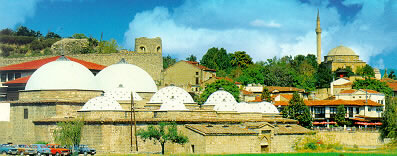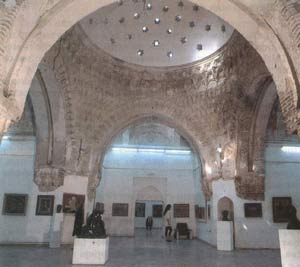Daut Pashin Amam
Previous | Home | Next
Daut Pashin AmamPrevious | Home | Next |
 |
| The
Daut Pasha Amam in Skopje is a monumental building of the secular Islamic
architecture. Its construction was financed by the great vizier of Rumely,
Daut-Pasha, who served in Skopje from 1489 until 1497. The names of the
builders are unknown.
The Amam (Turkish bath) is vaulted with a total of 13 domes, two of which are large, three are of a medium size, two are somewhat smaller, and six are small. There are 15 separate rooms under the domes. The Amam was divided into two parts: a waiting room and a changing room. The two large halls in the central part were furnished with beautifully and richly ornamented fountains. Some of the smaller rooms had white marble urns for collecting bathing water, while others served as saunas. The division of the Amam into two equal parts leads to the conclusion that it was simultaneously used by both men and women. Men used the west entrance, while the women entered through the north entrance. There was an east entrance as well, used by staff for servicing the amam. The size of the Amam roused the curiosity of anyone who would see it for the first time and kept wondering if its normal heating and functioning as a bath was possible. Hence the appearance of a few legends which express doubts if the Amam was ever used as a bath. One of them tells us that the wood, needed in very large quantities for maintaining the temperature in the rooms and of the hot water, was being brought from Mount Vodno nearby Skopje. The woods there were completely destroyed, however, and the lack of wood caused the closing of the Amam. Another legend tells of Daut Pasha’s daughter who visited the Amam prior to its opening. A huge poisonous snake came out of the walls and bit the girl, after whose death her father ordered that the Amam be closed down and it was never used for its original purpose. But there is no reliable evidence that the Amam was not used either. On the contrary, during the reconstruction of the building, thick layers of limestone were detected along the pipes through which water was coming into the Amam. In 1948, a decision was made to restore and convert the object. It was turned into an art gallery and has remained as such since. Its permanent exhibition displays the work of contemporary Macedonian artists from the end of the 19th century up to the present. In addition, collective and individual exhibitions of Macedonian and foreign artists are regularly organised, as well as readings and concerts. |
||
 |
||
 |
||